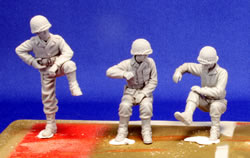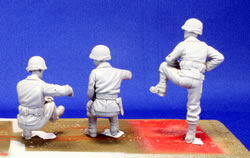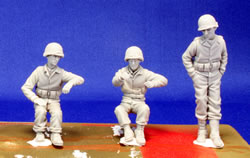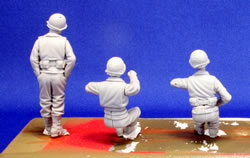|
U.S.
Half Track Crew |
 |
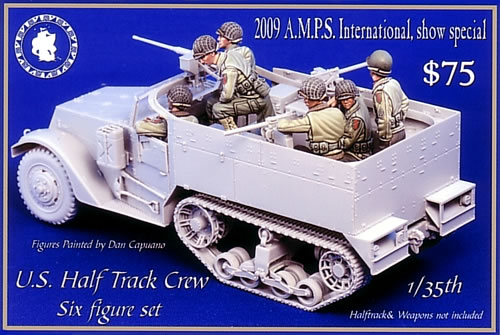
New World Miniatures It took nearly 40 years for WWII half-track modelers to get a new set of specially purposed HT figures. Of course, it took almost that long between the appearance of Tamiya's half tracks and DML's. Fortune finally smiled upon us with NWM's set of six finely rendered GIs, shown here occupying the DML M2. Out of the box, you couldn't ask for much more. In general (with an intriguing exception), the figures can be used from Operation Torch into the autumn of 1944. You could also switch in a few figures wearing M1943 combat jackets to work these guys into a spring 1945 setting. One figure has his left leg raised and bent and leans over convincingly. Another stands with his hands in his pockets. The remaining are sitting, and all are posed looking over their surroundings; expressions are muted and one is talking, giving a strong hint of wariness—or weariness. The uniforms offer an interesting variety, and one of the nice things about this set is that none of the soldiers wears webbing suspenders, presumably because they are armored infantry and their HT is well packed (the box art helpfully notes that the set does not come with weapons—nor half-track). Thus, like Tamiya's old set, they can be used as resting infantry who have lightened their load. Four figures have cartridge belts for M1 Garands, and all have the canvas leggings with their combat boots. The driver wears the winter combat jacket and no ammo pouches on his belt, but has tucked in a captured German pistol. Another figure wears a similar winter jacket, and three others have the 1941 field jacket, second pattern. The sixth figure (center in the left photo below), is an officer riding in the front passenger seat (as he's equipped with a .45 pistol). He wears what has all the characteristics of the herringbone twill camouflaged jacket. The camo uniforms (also featured in DML's U.S. Infantry, 2nd Armored Division) were short lived, basically from Operation Cobra in mid-July and on into August. The main differences between this jacket and a regular HBT version is that the camo jacket had hidden buttons down the breast, while the plain HBTs had five or more visible buttons. And lest one thinks it's an M1943 field jacket commonly seen beginning in the fall of 1944, the flaps on that jacket's breast pockets had their corners cut and were secured with buttons, and the sleeves had buttoned cuffs. The kit figure's breast pockets flaps are uncut and without buttons, and there are no buttons on the cuffs. Unfortunately, the figure is obscured in the box art, so one can't tell how he's intended to be painted. But if you don't want to give him the camo colorings, you could take your hobby knife and carefully trim the pocket flaps and add buttons where needed.
The trousers also provide a camo option, as two figures wear herringbone twill trousers with the pair of large cargo pockets on the thighs. For modeling purposes, these are virtually identical between camo and non-camo styles. Details are captured well. The pieces require some cleanup of seams and casting plugs. A few bubbles and attachment points, particularly where the arms meet the shoulders, need attention with some filler. Be careful not to remove the muzzle of the captured pistol carried by the driver, nor the bottom portions of the cartidge belt clasps.
The standing figure scales to just over 6', which is in line with most figures, if not the average height of that era. The heads are similar in size to Warriors spare head sets (and a bit larger than Hornet heads) if you are looking for more animated expressions. The real test, of course, is how well the figures fit into a half track, and I'm sorry I haven't yet built my DML M2s so I could report on this. But I suspect that all of us GI fans can easily make any adjustments necessary in order to crew up our carriers with something light years better than our old Tamiya friends. No sculptor is given credit on the box, but we owe him and Chris Mrosko at New Worlds Minatures a hearty round of applause for this welcome set. -tss |
 |
 |
 |
 |
 |
 |
 |
 |
 |
 |
 |
 |
|
